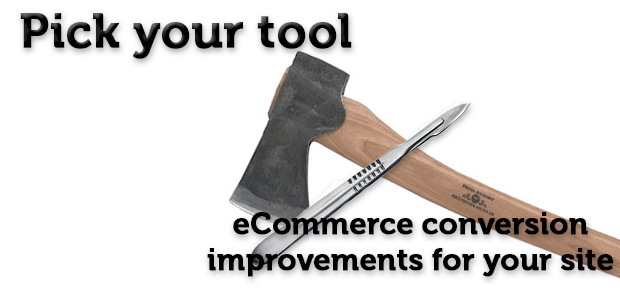
Axe vs. Scalpel – Full Site Redesign or Continuous Optimization
In a previous post, we discussed why during a site redesign you should engage your UX experts, whether internal or external, prior to working with designers. But should you even be conducting a redesign? This is a massive undertaking for any site, so you want to be sure it is worth the opportunity cost and the expense of any third parties you bring in to assist. There may be safer and less expensive ways to overhaul your site without doing a full-scale redesign. So before you start planning your project, you need to answer the big question:
Why do you want a redesign?
- Are you just trying to update the look and feel? If so, why?
- Do you need to update to newer technology, such as responsive design?
- Are you restructuring the site to engage existing users in a totally different way? Or are you trying to fix a specific problem(s) current users are having?
- Are you trying to address a new customer base? If so, how do they need to be treated differently from the current customers?

While any of these could be a good reason to redesign your site, you also need to consider your entrenched users:
- Are there important workflows that need to be preserved? If changed, what are the education requirements?
- If you expect to lose existing users due to these changes, are the new opportunities able to compensate?
A simple search of “common reasons for a site redesign” turns up pages of “Top X” lists of items like the above. The point is, you need to know the top goals for your website and how successful you currently are at meeting them. Once you’ve identified those goals, we can look at the main question a different way: “Are my goals only accomplished by a complete overhaul, or can the goals be accomplished by tackling the problems in smaller chunks?”
For some items, such as changing over to responsive design from a site that is not mobile-friendly, you will have to rework most of the site, which makes it an ideal time to consider this larger project – the axe.
On the other hand, if you’re able to identify specific pain points on your site, incremental change (i.e The Scalpel) can be a much better tool.
All cases are different, so it’s important to consider all the factors. The questions above should provide a good starting point, but there may be others specific to your business that only you can identify. When it comes down to it, most websites have clearly identifiable problems that can be fixed with incremental change. While it may seem like the slower approach – it takes longer for the entire site to be updated incrementally vs. all at once – often Continuous Optimization ends up being a safer investment that offers a larger return.
Site redesigns can take months to complete with no guarantee that the new version will outperform the old — pity the marketer who finds out after months of work that the shiny new site ended up losing to the original one. Moreover, if you make all the changes at once, you won’t know which changes were positive and which ones hurt.
A Continuous Optimization program that validates results through testing, on the other hand, can bring you incremental improvements in a much shorter time period without the expense or opportunity cost of an overhaul.
As you are working on the next optimization, you also reap the benefits of earlier optimizations, which compounds these improvements. With limited development resources, this has the added benefit of not tying up your entire team on one large project.
Ultimately, there will be cases where the axe is the right tool for the job. But if you can clearly identify the source of your site’s problems, the scalpel can address the pain — without the collateral damage and expense.











0 Comments